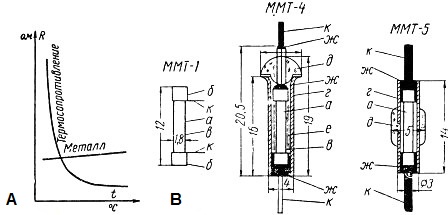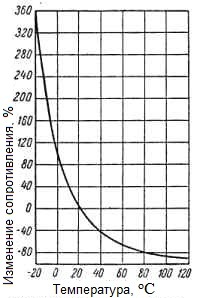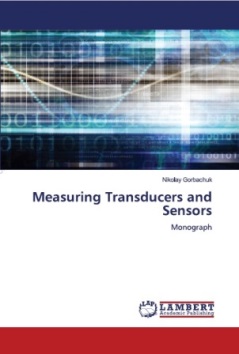Transducers, gauges, sensors - Information portal © 2011 - 2025 Use of material is possible by placing an active link

Semiconductor thermal resistances. Thermistors. Thermo-resistors. Principle of action and description
Physical principles of semiconductor thermistors. The design, specification, the temperature dependence of resistance.
Considerable dependence of resistance of semiconductors on a temperature allowed to construct sensible thermistors (thermal resistances, thermo-resistors), being semiconductor resistors with the large temperature coefficient of resistance. Depending on settings thermistors are made from matters with the different value of specific resistance of р . For making of thermistors semiconductors both with the electronic and with p-type mechanism of conductivity and unalloyed matters can be used. The basic parameters of matter of thermistors, qualificatory his quality, it is been: size of temperature coefficient at, chemical stability and temperature of melting.
Most types of thermistors reliably work only in certain temperature limits. Every overheat above of norm perniciously operates on thermistors, and sometimes even can result in his death.
For a protection from harmful influence of environment, and first of all oxygen of air, thermistors are sometimes placed in a bulb, filled with rare gas.
The construction of thermistors is very simple. Given shape the piece of semiconductor filament, bar, rectangular plate, marble or some another form. On opposite parts of thermistors two conclusions are mounted. Size of resistance of thermistor, as a rule, the more sizes of resistances of other elements of chart are noticeable and, it is most important, sharply depends on a temperature. Therefore when a current flows in a chart, his size is mainly determined in size resistance of thermistor or in final analysis by his temperature. With the increase of temperature of thermistor a current increases in a chart, and, vice versa, with a drop in a temperature a current diminishes.
Heating of thermostat can be carried out by the transmission of heat from an environment, by the selection of heat in thermistors at passing through him electric current or, finally, through special warming up windings. The method of heating of thermal resistance direct character is related to his practical use.
Resistance of thermistor with the change of temperature can change on three orders, i.e. in 1000 times. It is characteristic for thermistors, made from badly conducting materials. In the case of well conducting matters a relation is within the limits of ten.
Every thermistors possesses a thermal inertance which in one cases plays a positive role, in other - either does not have no value practically or negatively tells and limits the limits of the use of thermistors. Thermal inertia shows up in that a thermistor, exposed to heating, accepts the temperature of heater not immediately, and only after a while. Description of thermal inertia of thermistors can serve as so-called permanent to time of t. Permanent to time numeral equal to the that amount of time, during which a thermistor, before being at 0° C, and then carried on Wednesday with a temperature 100° C, will decrease the resistance on 63%.
For most semiconductor thermistors nonlinear character (figs. 1, А) has dependence of resistance on a temperature. Thermal inertia of thermistors small differs from inertia of mercury thermometer.
At the normal mode of exploitation the parameters of thermistors in time change small, and therefore tenure of their employment is great enough and depending on the brand of thermistors hesitates in an interval the top limit of which is calculated a few for years.
We will consider for an example three types of thermistors are short: ММТ- 1, ММТ- 4 and ММТ- 5.
On figs. 1(В) a fundamental device and constructions of these thermistors is shown. Thermistors of ММТ- 1 is covered outside of by an enamel paint and it is intended for work in dry apartments; thermistors of ММТ- 4 and ММТ- 5 are mounted in metallic capsules and pressurized. Therefore they are not subject to harmful influence of environment, intended for work in the conditions of any humidity and even can be in liquids (not operating on a corps thermal resistances)
Ohmic resistance of the thermistors is in a range from 1000 -200000 ohm at a temperature 20° C, and temperature coefficient of an about 3% on 1°С. On figs. 2 the crooked is represented, showing in percents the change of ohmic resistance of thermistor depending on his temperature. On this chart for an initial value resistance is taken at 20° С.
The described types of thermistors are counted on work in a temperature interval from - 100 to + 120° С. Overheating them unit admits.
Thermistors( thermo-resistors), of the mentioned types are very stable, i.e. save practically unchanging the "cold" resistance the size of which is determined at 20° C during very great while. High stability of thermistors of type of ММТ determines their large tenure of employment, which, as indicated in a passport, in normal their office hours practically boundless. Thermistors (thermo-resistors), of type of ММТ possess good mechanical durability.
On pictures: constructions of some thermistors, characteristic temperature dependence of resistance of thermistor.
look also Thermo - resistors
русский / english

Bases of work thermo-resistors
Thermo-resistors. Principle of work
Thermistors. Thermo-resistors
Platinum thermometers of resistance
Platinum and copper thermo resistances
Low-temperature (cryogenic) thermometers
Semiconductor lov-temperature thermoresistors
Home >> Temperature, thermoelectricity >> Semiconductor thermal resistances. Thermistors
• Information about various converters and sensors of physical quantities, parameters of various physical processes is presented.
• Electrophysical properties and effects in various electrical materials.
• Theory, experimental results, practical application
Fig.1.
A - The temperature dependence of the resistance and thermal resistance of the metal
B - RTD design and dimensions:
a - RTD body, б - contact caps, в - a layer of enamel paint, г - a protective metal cover, д - a glass insulator, e - a metal foil, ж - a layer of tin, к - conclusions
Figure 2. The temperature dependence of the resistance of the thermistor type MMT
See also: Food of various transducers, sensors, radio: Voltage stabilizers. Description Scheme

See also:
CONVERTERS, GAUGES, SENSORS
Information, news, advertising


